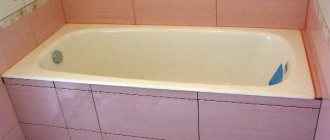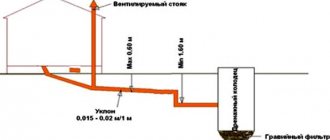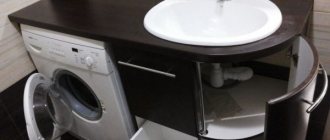The wall-hung bathroom sink, which gained popularity back in the days of the Soviet Union, is not losing its position. The simple method of fastening, compactness and attractive appearance appealed to many. Therefore, it is not surprising that mounted models are as relevant today as they were many years ago.
The range of such products has expanded significantly - plumbing fixtures differ in the material of manufacture, the shape of the bowl, the method of fastening and other parameters. How to choose the optimal model and install it?
We invite you to understand the variety of proposals and evaluate the strengths and weaknesses of different options. A balanced approach to the issue of choice is the key to a successful purchase.
In addition, we will help you install the plumbing yourself - the article provides a step-by-step guide for installing a wall-mounted sink with and without installation.
Types of wall-hung sinks
Manufacturers offer a huge range of different types of wall-hung sinks, which can be divided into several subgroups.
Hanging sinks with a cabinet or cabinet are convenient. These models are very popular if you need useful space in the bathroom.
The design with furniture has a number of advantages, for example:
- The cabinet is useful if you want to hide water pipes or a small water heater. At the same time, the appearance of the pipes does not spoil the appearance of the bathroom.
- You can also use the cabinet to store household items, chemicals, hygiene products, rags and cleaning buckets.
- The designers agreed that such designs look stylish, elegant and at the same time allow ergonomic use of space in a small bathroom.
But keep in mind that for wall-hung models, the cabinets are free-standing elements that can be moved away from the sink at any time. The bowl mounts are located on the wall, and it is the brackets or studs that support the products in a suspended state. It’s easy to disguise pipes with furniture.
A sink on a pedestal is also called a “tulip”. It received this name because of its slight resemblance to a flower. A distinctive feature of this type of sink is the presence of a pedestal or column.
Such models are made in a semicircular shape, but there are exceptions. For hanging models, the stand serves only a decorative function.
A neat ceramic half-tulip sink will fit perfectly into a stylishly decorated bathroom, thereby decorating the interior of the room
There are two types of tulip shells. The first type, with a pedestal, is easy to recognize by the column reaching to the floor; the semi-pedestal of the second type is attached to the wall directly under the bowl. If you compare them, a sink with a column is considered more stable.
We are interested in wall-hung bathroom sinks that are attached to the wall. Such models do not require additional stands or columns.
This is the best option if you want to install a sink made of ceramic. A product made from a heavier material, such as granite or marble, requires more serious installation and additional support in the form of a bedside table or stand.
Instead of a cabinet, you can place a washing machine under the sink (special mini-model) or a shelf.
Image gallery
Photo from
Mounting a sink on a load-bearing wall
Installing a sink on an installation
Double wall-hung basin
Wall-hung sink of non-trivial shape
Material for making sanitary fixtures
Before choosing a model, you need to familiarize yourself with the materials from which modern plumbing fixtures are made. Famous brands offer a wide range of products made from wear-resistant materials that do not lose technical and aesthetic qualities for many years.
An elegant and small wall-hung porcelain sink will decorate your bathroom and, with careful use, will serve you for many years
Sinks made of ceramics, stainless steel and some composite materials have high performance characteristics. Many buyers prefer products made from artificial material or natural stone.
Faience and porcelain . Such products are considered the most popular. Many people confuse these two concepts, although they have some differences. Porcelain is considered one of the more expensive materials due to its smooth, uniform structure and high density.
Earthenware is characterized by porosity and, accordingly, rapid wear: small cracks, if handled incorrectly, quickly turn into large ones. It is difficult to distinguish between a sink made of earthenware and porcelain, especially if the earthenware product is covered with a uniform protective layer that is stronger than the material itself.
Glass sinks . They are made not from thin glass, which cracks at the slightest impact, but from a tempered analogue with high-strength characteristics.
The stylish appearance attracts attention, but only until the first drops fall on the glass and it becomes covered with soapy stains. Glass sinks require special care.
A wall-hung washbasin made of tinted glass is perceived equally positively by both women and men, which is why it is popular among couples
Natural stone sinks have various modifications - they are made of granite, onyx or marble. The products are beautiful due to their natural patterns, but they are classified as hard to find due to their high cost.
The large weight of natural stone also dictates the installation conditions: it is better to prefer products with a stand in the form of a cabinet over hanging models.
Which form is more practical?
Usually, buyers try to choose a model that does not take up much space in the bathroom (this is a necessity for Khrushchev-era bathrooms) and has a convenient and safe shape. A wide range of such plumbing fixtures can be found in specialized stores, but their cost and quality vary.
Round and oval - more popular than other products with rounded edges. They are safe to use, which is important if there are children in the family. Among the snow-white models you can find options for a wide variety of designs: pastel and bright, matte and glossy, with patterns and ornaments.
Rectangular and square . If your bathroom does not have a shortage of space, you can afford a wall-hung sink with right angles.
The shape of the sink that fits well into a small bathroom, while saving space and not taking up the volume of the room
Designer models . They come in spherical, cone-shaped, triangular shapes. Sometimes hanging structures are part of a plumbing set and repeat the forms common to the entire collection.
Selection of sink dimensions
The width and length of suspended models are important for both users and installers. The former are interested in comfort when taking water procedures, while the latter are interested in the ability to connect the structure to communications and the wall.
Products that are too small are not practical - when you turn on the tap, splashes will scatter in all directions, creating puddles on the floor. As a result, mold will appear in places where moisture accumulates - in the corners.
Large washbasins cause installation problems due to excess weight, and given the size of typical bathrooms, it is difficult to install an oversized wall-hung sink. If you are interested in large sizes, it is better to opt for other models, with a pedestal or built into the countertop.
Based on the width of the bowl, wall-hung washbasins are divided into three groups:
- miniature – up to 55 cm;
- medium – 55-60 cm;
- above average - from 60 cm.
The first ones are conveniently placed in toilets located separately from the bathroom. They come in straight and angular, round and rectangular. The compact model for the toilet will find a place even in the cramped space, but you will have to take care of the supply of hoses with hot and cold water.
Also, when choosing the size of the sink, you should be guided by the depth of the product, which usually fits within a frame of 25-50 cm.
You should choose a hanging structure individually, focusing on height and ease of use. If there are children in the family and the footage allows, you can install a double model, where one sink is raised to a standard height, the second is lower.
If there is not much space in your bathroom, then choose a wall-hung corner sink model that will fit well into the room
Thus, when choosing a particular model, be sure to consider the dimensions of the bathroom. The dimensions of the previous model can help you, if you are completely satisfied with it, just take the dimensions before purchasing: width, length, exact location of the mixer installation.
Possible mounting methods
There are three options for mounting a wall-hung sink:
- on stiletto heels;
- on brackets;
- on the frame.
Option number 1 . A base is installed on the wall - a metal plate with fasteners, to which the bowl is suspended using pins.
Option number 2 . A more reliable method, since the brackets reliably support the bowl on all sides. This solution is the most popular, as the brackets are located under the sink and are practically invisible.
Image gallery
Photo from
Installation and connection of a wall-hung sink
Fixing the sink with pins
Brackets for massive devices
Additional support legs
Option number 3 . This method is used much less frequently. The frame resembles brackets, but, unlike them, it supports the bowl on all sides. The strength of the structure depends entirely on the quality of the frame installation.
The basis for a suspended structure is always a wall. If a cabinet or stand is installed under the sink, it most likely plays the role of a decorative element, masking the siphon and pipes. Otherwise, it will be a different type of sink.
Be careful when installing a wall-hung sink, otherwise you will scratch the tiles on the walls. Use a drill with protective tips to prevent chipping
What is required for installation?
Before purchasing a new plumbing product, you need to measure the bathroom and calculate the dimensions of your future sink. If you still have an old sink, and it suits you in all respects, then you can take measurements from it.
Before proceeding with installation, make sure that you have a complete set and instructions for installing a wall-hung sink; if there are any missing parts, contact the store to replace the product
It is worth checking the serviceability of sewer and water pipes so that no additional problems arise when connecting plumbing. Do not forget about such technical nuances as the diameter and angle of the pipes.
The following tools may be required for installation when installing a wall-hung sink:
- drill;
- adjustable wrench;
- level;
- Teflon tape;
- ruler or meter.
The listed items will help you quickly and effortlessly install a wall-hung sink in your bathroom.
You may also need additional keys and a pencil. Be sure to take care of purchasing the necessary plumbing fixtures - mixer and siphon.
For a siphon, the strength of the material and a suitable design are important; for a faucet, it is important to match the sink in style and size. At the preparatory stage, you will need to make some calculations and measurements so that the installation is successful.
Tools and materials
The best device for setting the vertical is a plumb line.
When installing wall-mounted washbasins, you need to perform all actions conscientiously, using only high-quality fasteners and serviceable equipment. A sink falling over can lead to the most dire consequences, both in terms of damage to the product itself and possible flooding.
To work you will need:
- perforator;
- Bulgarian;
- roulette;
- building level;
- square;
- plumb line;
- screwdriver;
- adjustable wrench;
- marker.
As for consumables, you must have the following:
- sealant;
- tile drill;
- bit for cutting concrete;
- set of rubber gaskets;
- anchor bolts, hooks, plastic dowels;
- safety glasses and gloves;
- rags.
When drilling holes, you need to change the drill bits in a timely manner. This is how a tile drill immediately becomes dull when it comes into contact with concrete. In turn, a concrete drill will not drill through the tiles, and when the device is switched to the “impact” mode, the tiles crack and fall off the wall. As for the diamond-coated drill bit, it drills equally well in tiles, concrete, brick and metal.
Instructions for installing a wall-hung sink
The main thing when installing a wall-hung sink is the correct location and strong fasteners, so first determine the main location and height of the sink using a ruler and pencil.
When designing the installation of a new product, first make sure that the wall is solid. If the walls are made of plasterboard, you will have to give up the idea of buying a wall-hung bathroom sink model
Step 1 . Mark with a line where the sink meets the wall. Check the level. Turning the sink over from the back, you will find the holes for the fasteners. Lean the sink against the wall and use a pencil to mark the points where the holes will be located.
Step 2 . Turn on the drill and drill holes in the places marked with a pencil. Insert dowels into the resulting holes - these are the most practical and reliable fastenings for heavy products.
Step 3 . Install the studs according to the pattern specified in the installation instructions. The studs should be long enough to fit the sink onto them and tighten the bolts.
Step 4 . Install the faucet on the sink, connecting flexible hoses to it - this way you won’t have to fiddle with the connection for a long time and in an awkward position.
Step 5 . To increase the density and strength of the fastening, apply a sealing lubricant to the back of the sink.
Step 6 . Attach the vanity over the mounting studs. Place the sealing inserts on them and tighten the nuts tightly.
Step 7 . Attach the siphon to the sink. You will find detailed instructions for its installation in the kit.
Step 8 . Connect the siphon to the sewer, flexible hoses to the hot water and hot water pipes.
Basic installation steps have been completed. After installation, check the horizontal level. Turn on the water in the tap and make sure it flows smoothly and without problems. Lean forward a little and make sure you can use the sink comfortably.
Drain connection
Before attaching the sink to the wall, you need to connect the drain - a water seal made of metal or plastic with corrugation or pipes. One of the best options for this device is the bottle model, which is easy to install and can be cleaned without much effort if a blockage occurs.
To connect the siphon to the outlet pipe, use union nuts and cone gaskets, following the instructions. They act in a similar way when assembling the element connecting the structure with the overflow.
First, a drain is assembled from individual elements and installed with an overflow. Then they install a corrugated water seal and connect the drainage device to the sewerage system. An important point is to check the drain for leaks. The operation of the mixer is also checked.
Close the drain valve with a stopper, fill the washbasin and watch as the water leaves through the overflow. Then the plug is removed and checked to see if the siphon is leaking. If there are no leaks, after installing the faucet and drain, work on the fasteners for the washbasin.
Tips from professional designers
Many experts recommend types of sinks that meet hygiene standards. In this case, purchasing porcelain products would be an excellent solution. They fully meet quality standards and have high wear resistance. In addition, porcelain is a material in the middle price segment, which means it is accessible to everyone.
Take advantage of the advice of qualified personnel in selecting a wall-mounted sink and other plumbing fixtures, then you will not have to frequently change or repair plumbing fixtures
Pay attention to the style of the bathroom. If you have a predominance of delicate pastel colors, then the best option would be a model made of glass or white earthenware/porcelain. Instead of shiny gloss, you can choose frosted glass, which is not so easily soiled and partially masks splashes flying in all directions.
Additionally, pay attention to the manufacturer. For example, Italian models from the Kerasan . The company has long been manufacturing stylish accessories and furniture for bathrooms.
When purchasing a wall-hung sink, do not forget about the material and size. For spacious bathrooms – large models, for small ones – compact ones.
If you find it difficult, choose products that are standard in size. These are suitable for installation in any bathroom, and you don’t have to spend effort or money to connect them.
But do not forget that the most important thing in choosing a wall-hung sink is that it is as easy to use as possible, durable, reliable and safe for all family members. Having chosen the model you like, get acquainted with the rules of installation and installation at home.
What types of designs are there?
Separation of sinks according to the material of manufacture:
- ceramic;
- glass;
- stone;
- metal.
Depending on the method of fastening, suspended structures are:
- with conventional wall mounting;
- on brackets;
- with a cabinet.
Typically, wall-hung sinks are attached to the wall using dowels and screws. This installation method is not suitable for heavy granite or marble products. In this case, special brackets are used, which create a stronger support for the washbasin. A very convenient option is a hanging cabinet with a sink located above it. Adds space to store necessary things without cluttering up the free space.











